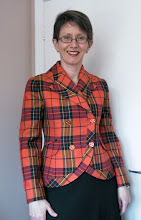First, let's recall the photo of the dress from the pattern envelope, and have a look at the line drawing.

There is one difference between these two that can readily be seen - the corners at the upper CF edge of the bodice meet in the photo but lie apart, allowing a V to form, in the line drawing. The drawing is an accurate depiction of the pattern; the photo is not. Perhaps the photo is of an actual Kay Unger dress rather than of the pattern made up. Luckily, I like the little V at the neck!
 Next I'll shame myself by posting a photo of my original muslin, made in (gasp) 2010. At the time, I weighed about 15lbs more than I do now, most of which was at or below the waist. This had led me to add approximately 1.25" (3cm) of width at the back skirt princess seams, and to grade the pattern out from size 10 at the waist to beyond size 12 at the hip side seams. I had also split the skirt front at the darts to make princess seams that allowed me to add more room at the hip. The skirt was still too tight at the time. Even though I'm slimmer now, I was comfortable keeping almost all these changes when I put the muslin back on. Maybe I just like more ease than Vogue intended
Next I'll shame myself by posting a photo of my original muslin, made in (gasp) 2010. At the time, I weighed about 15lbs more than I do now, most of which was at or below the waist. This had led me to add approximately 1.25" (3cm) of width at the back skirt princess seams, and to grade the pattern out from size 10 at the waist to beyond size 12 at the hip side seams. I had also split the skirt front at the darts to make princess seams that allowed me to add more room at the hip. The skirt was still too tight at the time. Even though I'm slimmer now, I was comfortable keeping almost all these changes when I put the muslin back on. Maybe I just like more ease than Vogue intendedMore serious were the fitting problems in the front of the dress where the midriff piece interacted with the bodice above and the skirt below.
I've annotated the photo of the muslin using Skitch to illustrate the fitting problems inherent in this pattern. I say "inherent" because some variant of these problems is evident in just about every example of this pattern I've seen in my internet travels.
The red and blue arrows point to some awkward pulling in the CF bodice pieces coming from the points where the fronts overlap. These pieces are not sewn together. Many who have made this dress had to stitch the overlapped side down to prevent the entire front from gaping open. This may in part be because they needed a FBA, but it is also due to the fact that there is a drafting problem with these pieces. The bodice felt and looked too short on me (and I've never needed an FBA!). The green arrows show the distortion that translated to the midriff piece from the fact that the bodice was too short between the princess seams.
At the same time, the skirt below the midriff felt and looked too long. It was pooching out. The black arrow shows the tuck I had pinned out to get rid of this extra length.
My friend G, who has a lot of experience fitting and sewing, commented that if the bodice was too short and the skirt was too long, it was probably the midriff piece itself that was the real problem. She is probably right, but the midriff piece seemed to be the right shape, and for me it was easier to adjust the pieces on either side of it.
 Once I added length (about 3/8" or .75cm at CF, tapering to nothing near the princess seams) to the lower edge of the bodice pieces and shaved approximately the same amount off the top edge of the front skirt pieces, the whole thing settled into place, as you can see at right. Phew!
Once I added length (about 3/8" or .75cm at CF, tapering to nothing near the princess seams) to the lower edge of the bodice pieces and shaved approximately the same amount off the top edge of the front skirt pieces, the whole thing settled into place, as you can see at right. Phew!To answer a question in the comments to my last post, the overlapping front is very secure and does not gape open, once it fits properly!
Next up: more info on construction. This dress is fully lined and as already noted, the bodice front overlaps. This means that the bodice fronts had to be finished to the CF edges before they could be attached to the midriff. You cannot construct the outer shell and the inner lining and attach them at the edges.
Vogue's instructions say to sew the front and back bodice pieces together (including topstitching) and join them at the shoulder, and then do the same with the bodice lining. Before the fronts are connected to anything, you can then machine sew the lining to the fashion fabric at CF and neck edges, and at arm openings, and turn it right side out. Then topstitch the CF and neck edges. All good. However, then Vogue wanted me to fully construct the other two vertical components i.e. the midriff and skirt, in each case sewing the side seams together, before attaching them at the horizontal seams. The midriff edges are supposed to be topstitched in one pass all the way around which makes for a nice smooth line at the side seams.

And the zipper comes dead last. No way! It's harder to sew in a zipper after the dress is fully constructed in the round. I decided to build the entire back and sew the zipper in flat before attaching the bodice fronts at the shoulder and clean finishing the bodice edges. Long story short, I completely finished the front and the back and sewed the side seams last which is completely not how Vogue wanted me to make this dress. I was very pleased when I was able to get the lines of midriff topstitching to line up almost perfectly at the side seams.
Take that, Vogue instruction-writers!




Lovely lines in this dress, suits you so well.
ReplyDeleteThe fit you managed to get on your dress is perfect. I always change the order of construction if possible so that the side seams are last, much easier to tweak the fit that way.
ReplyDeleteI always do the side seams last - makes sense if you are trying to do a final fit. Love this dress. Your version looks so good.
ReplyDeleteGorgeous dress! Over and over again I see experienced sewists, self included, put the zip in the back in the flat. When will the pattern companies see the wisdom of this, particularly for newbies?
ReplyDeleteBeautiful dress.
ReplyDeleteLike tip about doing the side seams last, I'm not an experienced dressmaker and this pattern looks daunting to me
ReplyDeleteYour dress is gorgeous on you. I is fitted to perfection. Love your step by step of how you got it that way.
ReplyDeleteI love this dress. I agree with you about the order of sewing -- so much easier to sew a zip flat and sew up the side seams last. Even for fitting reasons I like to hold off on the side seams. I wonder if the sewing instructions are better in the patterns produced by the indie pattern companies?
ReplyDeleteLove, love your dress and your persistence in making it work. I so agree that pattern companies should really re-evaluate their directions, particularly to encourage new sewists to have better results. I now know enough to change the sequence but it took me years to learn to make those changes and improve my results.
ReplyDeleteBeautiful - I have This this pattern Now I have seen your version I hope mine turns out as well
ReplyDeleteI own the RTW dress. It is in a heavy ponte. The center fronts overlap, are left free and the overlap is not sewn down. It fits snugly to the body in the bodice and has plenty of design ease below the waist. It appears almost exactly as your version except the RTW version is fashioned from much heavier fabric.
ReplyDeleteAnother excellent result. Brava!
Thanks for the information about the original!
DeleteThis is wonderful, Kay! It fits perfectly. I've always loved this dress and have been a little put off with all the trouble it seems to be to get a good fit on it, but your version is making me want to try this. Love it!
ReplyDeleteWow! Fits you perfectly! Beautiful!
ReplyDeleteYour dress looks great! I made this dress and I sewed it in the same order as you did. It's easier to make alterations to the fit later. If I gain some weight, all I have to do is let out the side seams.
ReplyDelete